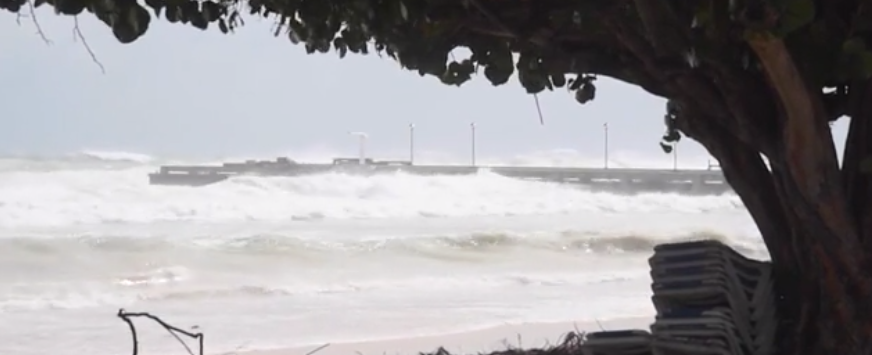Bridgetown: Hurricane Beryl strengthened to Category 5 status late Monday after it ripped doors, windows and roofs off homes across the southeastern Caribbean with devastating winds and storm surge fuelled by the Atlantic’s record warmth.
Beryl made landfall on the island of Carriacou in Grenada as the earliest Category 4 storm in the Atlantic, then late in the day, the National Hurricane Center in Miami said its winds had increased to 160 mph (260 kph).
Fluctuations in strength, and later a significant weakening, were forecast as the storm pushes further into the Caribbean in the coming days.
Grenada’s Prime Minister Dickon Mitchell said one person had died and he could not yet say if there were other fatalities because authorities had not been able to assess the situation on the islands of Carriacou and Petite Martinique, where there were initial reports of major damage but communications were largely down.
“We do hope there aren’t any other fatalities or any injuries,” he said. “But bear in mind the challenge we have in Carriacou and Petite Martinique,” Mitchel added that the government will send people first thing Tuesday morning to evaluate the situation on the islands.
Streets from St. Lucia island south to Grenada were strewn with shoes, trees, downed power lines and other debris. Banana trees were snapped in half and cows lay dead in green pastures with homes made of tin and plywood tilting precariously nearby.
“Right now, I’m real heartbroken,” said Vichelle Clark King as she surveyed her damaged shop in the Barbadian capital of Bridgetown that was filled with sand and water.
Beryl was still swiping the southeast Caribbean late Monday as it pushed into the Caribbean Sea on a track heading just south of Jamaica and toward Mexico’s Yucatan Peninsula by late Thursday as a Category 1 storm.
Beryl was about 510 miles (825 kilometres) east-southeast of Isla Beata in the Dominican Republic and was moving west-northwest at 22 mph (33 kph). A hurricane warning was in effect for Jamaica, and a tropical storm warning for the southern coast of Hispaniola, the island shared by Haiti and the Dominican Republic.
Fluctuations were likely but Beryl was expected to stay near major hurricane intensity as it moved into the central Caribbean and passed near Jamaica Wednesday, the National Hurricane Centre said. After that, significant weakening was expected.
The last strong hurricane to hit the southeast Caribbean was Hurricane Ivan 20 years ago, which killed dozens of people in Grenada.
Monday afternoon, officials received “reports of devastation” from Carriacou and surrounding islands, said Terence Walters, Grenada’s national disaster coordinator. Mitchell said he would travel to Carriacou as soon as it’s safe, noting there’s been an “extensive” storm surge.
Grenada officials had to evacuate patients to a lower floor after hospital roof was damaged, he said.
“There is the likelihood of even greater damage,” he told reporters. “We have no choice but to continue to pray.”
In Barbados, Wilfred Abrahams, minister of home affairs and information, said drones — which are faster than crews fanning across the island — would assess damage once Beryl passed.
Jaswinderpal Parmar of Fresno, California, who was among the thousands who travelled to Barbados for Saturday’s Twenty20 World Cup cricket final, said he and his family were now stuck there with scores of other fans, their flights cancelled Sunday.
He said by phone that it’s the first time he has experienced a hurricane — he and his family have been praying, as well as taking calls from concerned friends and family as far away as India.
“We couldn’t sleep last night,” Parmar said.
Historic hurricane
Beryl strengthened from a tropical depression to a major hurricane in just 42 hours, which only six other Atlantic hurricanes have done, with September 1 as the previous earliest date, according to hurricane expert Sam Lillo.
It also was the earliest Category 4 Atlantic hurricane, besting Hurricane Dennis, which became a Category 4 storm July 8, 2005.
Beryl later became the earliest Category 5 observed in the Atlantic basin on record, and only the second Category 5 hurricane in July after Hurricane Emily in 2005 the National Hurricane Centre said.
Beryl amassed its strength from record-warm waters that are hotter now than they would be at the peak of hurricane season in September, said hurricane specialist and storm surge expert Michael Lowry.
Beryl also marked the farthest east that a hurricane has formed in the tropical Atlantic in June, breaking a record set in 1933, according to Philip Klotzbach, Colorado State University hurricane researcher.
Beryl is the second named storm in the Atlantic hurricane season, which runs from June 1 to November 30. Earlier this month, Tropical Storm Alberto made landfall in northeast Mexico and killed four people.
Short-lived Tropical Storm Chris had formed Sunday night near eastern Mexico before weakening back to a depression Monday. A cluster of thunderstorms mimicking Beryl’s path in the western Atlantic was less organised late Monday but had a small chance of becoming a named storm in the next few days.
The National Oceanic and Atmospheric Administration predicted the 2024 hurricane season was likely to be well above average, with between 17 and 25 named storms. The forecast called for as many as 13 hurricanes and four major hurricanes.
An average Atlantic hurricane season produces 14 named storms, seven of them hurricanes and three major hurricanes.
PTI
